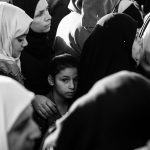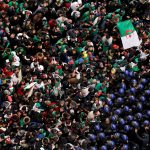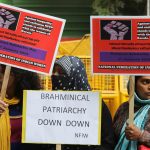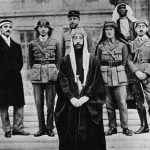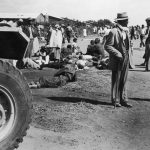Long Read | No other choice for Palestinians
An interview with Ahmed Abu Artema, one of the founders of the Great March of Return that sees Gazans demonstrating peacefully every Friday for an end to the Occupation.
Author:
25 April 2019

As part of a dossier on the international movement for Palestinian liberation, Viewpoint asked psychologist and scholar Lara Sheehi to interview Ahmed Abu Artema, one of the main organisers of the Great March of Return.
Interview and English translation by Lara Sheehi
Lara Sheehi: Would you mind first introducing yourself to our readers, knowing how important the question is in the context of Palestine.
Abu Artema: My name is Ahmed Abu Artema, a Palestinian activist from a displaced family, a displaced Palestinian from the Ramla region, we were displaced in 1948 when Israel founded its state. The year after the state was founded, about 700 000 Palestinians were displaced and my family was among them. I was born in the city of Rafah. I am a human rights activist and a journalist.
I was one of the founders of the Great March of Return that represents the claim of Palestinians to their natural right that is understood and guaranteed to them under international law and by United Nations conventions: that they should be allowed to return to their homes.
Related article:
LS: You mentioned that you were a journalist and I also know you’re a poet. We know that Palestinians are very engaged and involved in art of all kinds – what’s the role of art and artistic expression in the Great March of Return? What is its importance? Has the March presented new possibilities to use art and performance?
AA: Yes, of course, art is one type of resistance. The Israeli Occupation project is a project of oppression of the Palestinian people. So we want to fully engage in all aspects of life and we want to say: we’re here, we’re present. That’s what’s happening. We are present, showing that we can engage in life, we’re present, we’re still here. This is one of the main currents of the March.
Palestinians resist in many ways: they resist through art, they resist through painting, they resist by dancing the national dabke, they resist by a show of national pride, they resist through beautiful music, they resist in all these ways. Art and artistic expression, to us, are a message that challenges those who desire our erasure. It is a message that proves that we deserve to be alive, we are engaged in this life despite being confined and imprisoned, our whole life, within Israeli walls.
Related article:
LS: This is what you refer to as peaceful resistance.
AA: Yes, it is a model of resistance that we use against the Occupation. The Occupation’s purpose is to communicate to the world and to people that we do not exist. We then prove that we do exist. We exist in everything. We exist in living our everyday lives. We exist in steadfastness on our land, despite all the pressures that are put on us by the Occupation. We exist in the olive trees that we planted a century ago and that are still present. We are present in the images of our heritage that connect us all. With this, we defeat the machinations of the Occupation.
LS: In your opinion, then, arts and artistic expression fall under the umbrella of steadfastness.
AA: Yes, steadfastness is a type of challenge to the Occupation. And steadfastness is a life commitment and vision whose sole aim is life, not death. The Occupation is a death drive.
LS: I wonder if you can talk to us about the types of artistic expression that spontaneously emerged in the Great March of Return.
AA: Refugees demonstrating in the March have been engaged in a variety of artistic expressions. This was especially present in spontaneous singing, especially songs about longing for Return, and the love of our land that drives the desire to Return back to our homes. We also saw a spontaneous Key of Return exhibition – this is the key that refugees kept from their homes, that they bring out yearly. We also saw sporting events that were organised and took place in front of the fence.
We are intent on sending a message: we are a people that love life. We even witnessed weddings, near the fence, weddings, people that began their life together, linked themselves, in proximity of the fence. We are amplifying this message. The Occupation is intent on keeping us in a depressive state, it doesn’t want us to see any sign of life.
Related article:
LS: There is an Arab American scholar who has said that Palestinians are “the worst victims”, meaning they refuse to bow to the enormous pressures to become the victims of forced erasure. What do you think of that characterisation?
AA: Yes, Palestinians have been through a considerable amount of oppression throughout their lives, but they remain strong. They’re not strong politically, or militarily. They actually need help from all those who love and fight for freedom in the form of political support and all types of support. But, Palestinians are strong by virtue of their roots, tied to this land.
I don’t think the Occupation has left even one Palestinian in its midst for which it hasn’t created a personal story of loss, in one way or another. For example, problems for their family that have lasted decades, refugee status, house demolition – every family has one of these stories. But the Palestinians, anything that is tied to the fate of their Return, they are very attached to it. They will not surrender.
LS: In your opinion, outside Gaza, even throughout historic Palestine and the West Bank, but also outside Palestine, what do you think people can do to help the people of Gaza in this movement you all have created?
AA: In my trip [through the United States], I’ve felt and have been embraced by a great deal of love. I saw and met many wonderful people that are in solidarity with Palestinians and that feel like Palestine lives in their hearts. This has rejuvenated my spirit.
We see and experience every person who loves and fights for freedom as a partner of ours. We are in the same struggle, fighting the same fight. The struggle is connected because it is about ending oppression, and ending oppression is a goal that will benefit humanity in its entirety.
We, Gaza, need so much. Gaza, currently, is inhospitable to life, unfortunately. People there are steadfast, but still need so much support from abroad. We are demanding an immediate change in these circumstances. We are calling for a worldwide movement, worldwide pressure that can relay a strong and clear message to those who have decision-making powers, and those who have political clout in various countries – the US, for example – that this siege must end.
This siege is not politically necessary nor is it a tool against terrorists, as Zionist propaganda portrays it. This siege is hurting children, the sick, the sick who can’t get treatment because of the siege. There are children who are denied food, medication, this is unacceptable. The siege must end because it denies basic human rights. This is the essential message that we want to communicate to all those who have decision-making powers. We want people to join us, join us in amplifying this message, join us in proliferating the call. We request for them to join us in boycotting the Occupation. We ask this because the money that supports the Occupation turns into bullets and tanks.
Related article:
LS: You’re communicating to us that the BDS (boycott, divestment and sanctions) movement is necessary, it helps.
AA: Yes. Encouraging the BDS movement is key. Calls for boycott are not aggressive. Calls for boycott are a call to join forces in opposition to oppression, against human rights abuses. The money that the international community and foreign states pay to the State of Israel transforms into bullets that puncture the beds of sleeping children. Just in the last two weeks, three children were murdered in Gaza. This is what comes from your tax dollars.
The money gets transformed into annexation of land, into construction of separation walls. In the end, the people of the US are free to do what they want with their money, but instead of supporting social causes within the US, or going toward healthcare, one of the first priorities of the US government is to support a project that is fundamentally built on the annexation of land from indigenous people, murder of those people and a continuation of their oppression.
LS: This is a really vital message to disseminate to the people of the US, because you’re saying that if there’s a collective effort toward boycott, and a withdrawal of financial support, there is a chance that the occupying forces will be forced to stop demolitions, stop murdering Palestinians. This is a real and immediate effect of boycott. And something concrete that people can do to support you.
AA: Yes, and in addition to this, Gaza needs a lot. We hope that you all will be in solidarity with our movement to end the siege. For example, maybe there can be organised efforts to come to the Erez checkpoint at Gaza, as a humanitarian convoy, or as a medical convoy, or as human rights convoy, to try and get to Gaza. Even numbering in tens, though we would hope for hundreds, to try and get into Gaza. We need people and numbers to disrupt the Occupation, to deliver a strong message that the siege and imprisonment of 1.8 million people is not a natural nor acceptable condition, and to support those who are there, living and surviving every day.
LS: To remind and prove to the Occupation and occupying forces that we, as an international community, have not forgotten the Palestinians in Gaza.
AA: Yes – we would love to see a global organising movement to help end the siege of Gaza. Because this siege cannot go on, it’s unacceptable.
LS: That’s absolutely right. In your opinion, what’s the most misunderstood aspect, or perhaps even outright lie, about the Great March of Return, that is peddled by the Israeli state and Zionists, or accepted by the media in general? Is there anything you would like to correct for people who are witnessing these demonstrations and perhaps are listening to the wrong voices or narratives that surround them?
AA: We want people to know the reality and truth of what’s happening in Palestine. The reality is that Israel is in violation of international law and is committing human rights abuses, by making refugees out of upwards of five million Palestinians, by building walls that have transformed our lives into open-air prisons. The West Bank is filled with walls and checkpoints that disconnect people from each other and the Gaza Strip is a prison, a true prison. The Gaza Strip is very small, you can get from one end to the other in an hour, it’s very small.
These people, what Israel is doing to them and against them is just because they are Palestinian. Because they are ethno-nationalist racists. We want people to know what’s really happening. Palestinians desire freedom. Palestinians desire dignity. Palestinians desire human rights. We don’t want walls. It doesn’t make sense that in the 21st century, there are humans that are caged in by walls and can’t interact with each other.
Israel has put up walls to cage in millions of people. We want these walls to come down. We want Israel, we want people to hold Israel accountable, to follow international law. We want Palestinian refugees to have the Right of Return and to have liberation. And ultimately, to have everyone live together, Israelis and Palestinians, with equal human rights.
Related article:
LS: These are such important insights for the larger picture, for anyone who wants to support Palestinians. Is there anything specific to the Great March of Return that you’d like to dispel or want us to know? Perhaps they just don’t know, or perhaps Zionist voices are misrepresenting. What would you tell them to let them know with accuracy what is happening on the ground during the demonstrations?
AA: I want them to know that the Great March of Return movement is derived from the fact that the Palestinians have not forgotten where they came from, the homes from which they were forcibly removed and displaced 70 years ago, and that this hope and desire to return has not stopped and won’t die. No matter how many years and how many decades pass, the will and desire to return will not disappear.
Why do they want to return? Simply put: without complicating it with any other factors, it’s their right. That’s first. Secondly, we want them to know: why have people been demonstrating for a full year? It is in response to Israeli violence. The Israeli state has murdered more than 200 peaceful protesters over the course of this year without them presenting any threat against Israeli forces, and they’ve injured over 25 000 demonstrators that haven’t threatened them in any way.
Despite this, people continue to demonstrate. Why? Because the issue of Return is a cry for life. We have no choice but to break free from behind prison walls. Like Ghassan Kanafani asked [in his story Men in the Sun], why didn’t the men bang on the walls while they were suffocating? Our people don’t want to die in silence, they want their cry to be heard around the world. Because they want to live. We want this cry, this scream, to get to our oppressors.
LS: Yes, like Kanafani said: “The Palestinian people prefer to die standing than to lose their cause.” You’d rather die in dignity, struggling, than on your knees, at the hands of the oppressor. It’s important that you feel they won’t bring you to your knees, that you will continue the struggle, defending yourselves, your rights.
AA: Yes, that’s right.
LS: The US mainstream media outlets and the Israeli state often talk about or present the Great March of Return as the brainchild of Hamas and that Gazans are intent on breaking through the fence and pouring into Israel to kill Israelis, or that children are being used as human shields, etc. Can you tell us how it looks every week? How are the demonstrations organised? Are there leaders? What does a typical Friday look like?
AA: I want to first reply to the suggestion or rumour that Hamas is organising these demonstrations. First of all, this is a deceptive trick, sold to the world. Secondly, this is really insulting to us, as a people – we’re not some robots that are controlled by a master.
LS: As though you don’t have your own thoughts or opinions…
AA: Exactly. We have thousands of people, men, women, children, elderly folks coming out. The first day we started, I saw older folks with canes, people who can’t walk well, pass us younger, able-bodied people, walking a kilometre just so that they can participate in the demonstrations.
The Great March of Return and the issue of Return are a collective choice and all Palestinians are participating, no matter their political affiliations. The Palestinian cause is a call for participation that allows us to collectively resist the Occupation from winning. Okay, all types of political affiliations are present – but it’s for the right of the Palestinian people. What about the right of Return? What about refugees? These are the things we’re all called to focus on when we fight for the Palestinian cause.
Related article:
LS: Can you tell us more specifics about Friday demonstrations?
AA: There is a society, an organising society, the National Society for the Right of Return and for Ending the Siege. This is a society that acts as an umbrella for all things of this nature for the Palestinians of Gaza, cultural and political. The society is the one that organises every Friday, invites people to the demonstrations. The programmes on Friday begin typically at noon. People come together in groups and public gatherings, peaceful of course, and they sing national songs and put on performances.
The occupying forces are not in any danger, they’re not threatened in any way. Even if people get close to the fence, even if they engage with the soldiers in chants, there’s no threat that’s being imposed on Israeli forces. They’re protected by fences, by their security detail, by heavily armoured vehicles. So in this regard, people really are coming together in peaceful protest, but it’s the Occupation that is intent on making this violent and dragging them into a bloody event.
LS: How do you understand the role of women and girls in the Great March of Return every Friday?
AA: Women are actively engaged in this movement and there have also been many martyrs that are women as a result. If you remember Razzan Al Najjar, she died for her Right to Return, she was a woman who had a very active role in the demonstrations. Every Friday I see thousands of women actively engaging in the demonstrations; some of them have been murdered, others have been injured.
LS: The coverage and videos I have watched support what you’re saying, but I’m not sure what others have been watching. I think much of the mainstream media, by way of Islamophobic tropes, view everything through the lens of a Hamas obsession, for example, Hamas oppresses women. This obsession literally blocks them from seeing reality in front of them, where we see and understand women as engaged in this movement as well.
AA: In the end, and maybe this is a bit outside our topic, but the Palestinian culture has its own beliefs and practices, just like any other culture does, a human right to maintain its cultural practices. But our cultural beliefs do not include oppressing women or restricting their freedom. Women are a central part of every facet of our culture, they have active roles. They are leaders in this movement, not just appendages or add-ons. And we all come together around this movement and play various roles.
Related article:
LS: This movement is a peaceful movement. You were in a documentary made by Al Jazeera, Between Fire and Sea: The Man Behind Gaza’s Great Return March. There’s a scene in it, you’re speaking to another man who says, paraphrasing, that you should respond to violence with violence. And you say to him, again paraphrasing, we can’t, we have to stay peaceful because remaining peaceful shows our strength.
Can you tell us about the tension between peace and this idea of violence, especially in the context of incongruent experience of violence – that is, when the violence experienced by Palestinians at the hand of the Zionist State is not the same as violence enacted by Palestinians, with very little power.
AA: Yes, that’s right. Our job is to focus on the main point: the issue is the Occupation. We shouldn’t be focusing on the various ways people who are under occupation decide to respond to or resist that occupation. Because of this, those young people, they’ve lived their whole life, almost, most of them haven’t left the open-air prison of Gaza – at all. Most of them have never left Gaza even once since they were born. All these young people are the victims of the occupation, firstly.
Secondly, they’re the victims of the siege and the oppression that comes as a direct result of the Occupation. The issue in Gaza is really dire. These youth in Gaza have no hope for their life, they have no options, so it’s not fair for me to blame these youth when they think about expressing their anger and aggression. This is not the real issue.
On a personal level, I lean towards peaceful struggle. Yet I can’t [help] but understand the context and the environment that creates the choice for violent struggle for these youth. Because these youth are victims – they wouldn’t have courage if they didn’t feel victimised by the Occupation. So the core and real issue is the Occupation and the consequences it has made for these youth that have created this helplessness. It’s on us to explore the reasons behind their actions instead of blaming or scrutinising the behaviours of the oppressed victim.
LS: Do you feel that the fixation and misattribution of violence to the Palestinians is intended to deflect from the Occupation itself? It seems like this approach might be used to locate blame in the victims.
AA: This is something that’s so obvious, I think. This is what I always come back to: what is the root of the problem in Palestine? The root of the problem in Palestine is that this people used to live on their land, and by force and by terror and coercion, in 1948 they were forcibly removed from their land. So now this people lives fragmented, in diaspora, and Israel still doesn’t leave them alone. They took their land, they built walls, they set up checkpoints, they take revenge on us every day – this is the issue. A sense of truth and justice has to make us focus on the real issue.
Related article:
LS: This analysis is available and used widely in Palestine, especially among the youth I’ve spoken to. It seems that this is the analysis that drives Palestinians in their various stances on resistance. It doesn’t appear to me that youth, or others, are engaging in “violence” just for its own sake; it’s not empty. They have a solid analysis that is tied into their existence in a settler-colonial condition, and they’re asking themselves: what do we have left to lose?
AA: That’s true. I’m always surprised, I can’t believe that there are people still out there who can’t see the reality and truth of the occupation of Palestine, the reality of the refugees, the reality of the Nakba, all these things that have happened to the Palestinians. That’s the truth.
LS: Given all this, how are people in Gaza dealing with the deaths that happen every Friday and the disproportionate violence from Israeli forces? How do they continue to maintain their momentum in the face of significant losses?
AA: Yes, the Occupation continues even if we’re demonstrating. They’ve murdered people on a weekly basis, but the Occupation doesn’t just kill us with live ammunition.
We’ve been slowly being killed for 70 years. We were killed when we were forcibly displaced, we are killed daily by the Occupation, we were killed when they forcibly transferred us. The youth’s hopes and futures have been killed off, they’ve wasted their futures. We’ve been killed by the siege, by the blockade of basic necessities, medical supplies. The Palestinian people are tired. They’re really tired and sad, but we don’t surrender. All these sacrifices, yes, they widen and reopen our wounds and intensify our pain, but they also clarify for us and re-energise us, because this Occupation really is a heavy burden on us.
LS: What has become evident to me over the years, and in any case of state violence against a people: even if you are entirely peaceful, without making a peep inside Gaza, you are literally in prison.
AA: Exactly!
LS: People see that there are demonstrations happening, but with or without these demonstrations, you’re in prison.
AA: That’s exactly right – we’re in a real-life prison in the Gaza Strip. The siege itself is an act of aggression. Aside from everything else, the siege itself is an act of aggression. Before the Occupation killed demonstrators in the Great March of Return, it killed the sick, it killed the sick by refusing them medicine over the past 11 years. We have no other options. The Great March of Return is a collective decision so that we can live.
LS: You are all peaceful and they’re acting in this way. It’s not like the Israeli forces would be peaceful or magnanimous if you weren’t demonstrating.
AA: Honestly, from the first day that the Great March of Return kicked off, the Israeli forces acted on political decisions and tactics and not because it was forced to intervene in any way. There hasn’t been any reason for them to intervene, at all, especially by using military force against unarmed protesters.
The Israeli forces are intent on quashing any will to resistance within us, and to eliminate within us any will toward the refusal to die. So it’s really the Occupation that desires death and violence. If the Occupation were really honest in its propaganda that we are all terrorists and extremists, then why wouldn’t you open up the possibility for a new experience, a new understanding regarding Israel and Israelis for the youth? The Great March of Return would have been the perfect opportunity for that!
All Palestinians present were committed to peaceful protest during the March. But the Occupation eliminated this hope entirely with its commitment to and entrenchment in bloody warfare. They are communicating, sending a clear message to Palestinians and peaceful protesters: Don’t you dare try!
Related article:
LS: Ahmed, I have one last question before we end today. What do you think, and perhaps alongside your colleagues and partners in the movement in Gaza – what do you think, what’s the vision you have about the liberation of Palestine? And what do you want people outside of Palestine to know so they can join you and support you in this vision?
AA: All I dream about is to live as a full human. To live with rights. To live with equal rights. To live within international rights conventions. I have no desire to destroy Israelis. I just want to end the Occupation and the racist disparities that exist. After that, and after refugees are allowed to return to their homes and are allowed to live like full humans with full rights, we can live together, as one, in one nation, linked together over human issues, not issues of the Occupation and racism.
LS: We thank you so much, Ahmed, and I’m so happy I had the chance to meet you this way and I hope I am allowed entry into Gaza and get to meet you in person, in Palestine.
AA: I truly wish that could happen. I hope that there are continued collective efforts toward this, groups of people trying to enter Gaza to help end the siege.
This article was first published in Viewpoint Magazine.





